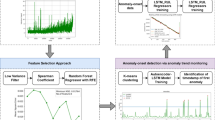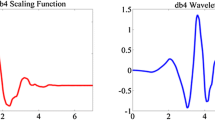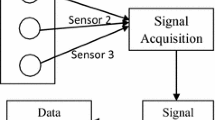Abstract
The vibration signal contains a wealth of sensitive information which reflects the running status of the equipment. It is one of the most important steps for precise diagnosis to decompose the signal and extracts the effective information properly. The traditional classical adaptive signal decomposition method, such as EMD, exists the problems of mode mixing, low decomposition accuracy etc. Aiming at those problems, EAED(extreme average envelope decomposition) method is presented based on EMD. EAED method has three advantages. Firstly, it is completed through midpoint envelopment method rather than using maximum and minimum envelopment respectively as used in EMD. Therefore, the average variability of the signal can be described accurately. Secondly, in order to reduce the envelope errors during the signal decomposition, replacing two envelopes with one envelope strategy is presented. Thirdly, the similar triangle principle is utilized to calculate the time of extreme average points accurately. Thus, the influence of sampling frequency on the calculation results can be significantly reduced. Experimental results show that EAED could separate out single frequency components from a complex signal gradually. EAED could not only isolate three kinds of typical bearing fault characteristic of vibration frequency components but also has fewer decomposition layers. EAED replaces quadratic enveloping to an envelope which ensuring to isolate the fault characteristic frequency under the condition of less decomposition layers. Therefore, the precision of signal decomposition is improved.
Similar content being viewed by others
References
HUANG N E, SHEN Z, LONG S R, et al. The empirical mode decomposition and the Hilbert spectrum for nonlinear and non-stationary time series analysis[J] Proceedings of the Royal Society of London A: Mathematical, Physical and Engineering Sciences. The Royal Society, 1998, 454(1971): 903–995.
SHUKLA S, MISHRA S, SINGH B. Power quality event classification under noisy conditions using EMD-based de-noising techniques[J]. Industrial Informatics IEEE Transactions on, 2014, 10(2): 1044–1054.
YANG G, LIU Y, WANG Y, et al. EMD interval thresholding denoising based on similarity measure to select relevant modes[J]. Signal Processing, 2015, 109: 95–109.
GUO W, PETER W T. A novel signal compression method based on optimal ensemble empirical mode decomposition for bearing vibration signals[J]. Journal of Sound and Vibration, 2013, 332(2): 423–441.
GUO C, AL-SHUDEIFAT M A, YAN J, et al. Application of empirical mode decomposition to a jeffcott rotor with a breathing crack[J]. Journal of Sound and Vibration, 2013, 332(16): 3881–3892.
WANG C, GAN M, ZHU C. Non-negative EMD manifold for feature extraction in machinery fault diagnosis[J]. Measurement, 2015, 70: 188–202.
GUO W, PETER W T. Enhancing the ability of ensemble empirical mode decomposition in machine fault diagnosis[C]//Prognostics and Health Management Conference, Portland, USA, October 10–14, 2010: 1–7.
COLOMINAS M A, SCHLOTTHAUER G, TORRES M E. Improved complete ensemble EMD: a suitable tool for biomedical signal processing[J]. Biomedical Signal Processing and Control, 2014, 14: 19–29.
CHANG C C, KAO S C, HSIAO T C, et al. Assessment of autonomic nervous system by using empirical mode decomposition based reflection wave analysis during non-stationary conditions[J]. Physiological Measurement, 2014, 35(9): 1873–1883.
GAO L, ZHANG Y, LIN W, et al. A novel quadrature clutter rejection approach based on the multivariate empirical mode decomposition for bidirectional Doppler ultrasound signals[J]. Biomedical Signal Processing and Control, 2014, 13: 31–40.
WU Z, HUANG N E. Ensemble empirical mode decomposition: a noise-assisted data analysis method[J]. Advances in Adaptive Data Analysis, 2009, 1(1): 1–41.
WU Z, HUANG N E, CHEN X. The multi-dimensional ensemble empirical mode decomposition method[J]. Advances in Adaptive Data Analysis, 2009, 1(3): 339–372.
BAGHERZADEH S A, SABZEHPARVAR M. A local and online sifting process for the empirical mode decomposition and its application in aircraft damage detection[J]. Mechanical Systems and Signal Processing, 2015, 54: 68–83.
LI Y, XU M, WEI Y, et al. An improvement EMD method based on the optimized rational Hermite interpolation approach and its application to gear fault diagnosis[J]. Measurement, 2015, 63: 330–345.
ALI J B, FNAIECH N, SAIDI L, et al. Application of empirical mode decomposition and artificial neural network for automatic bearing fault diagnosis based on vibration signals[J]. Applied Acoustics, 2015, 89: 16–27.
GEORGOULAS G, TSOUMAS I P, ANTONINO-DAVIU J A, et al. Automatic pattern identification based on the complex empirical mode decomposition of the startup current for the diagnosis of rotor asymmetries in asynchronous machines[J]. Industrial Electronics, IEEE Transactions on, 2014, 61(9): 4937–4946.
ZHANG J H, LI L J, MA W P, et al. Application of EMD-ICA to fault diagnosis of rolling bearings[J]. Chinese Journal of Mechanical Engineering, 2013, 24(11): 1468–1472.
LIU X, BO L, LUO H, et al. Bearing faults diagnostics based on hybrid LS-SVM and EMD method[J]. Measurement, 2015, 59: 145–166.
XU D, ZHU Q, CHEN X, et al. Residual fatigue life prediction of ball bearings based on Paris law and RMS[J]. Chinese Journal of Mechanical Engineering, 2012, 25(2): 320–327.
VAN M, KANG H J, SHIN K S. Rolling element bearing fault diagnosis based on non-local means de-noising and empirical mode decomposition[J]. IET Science, Measurement & Technology, 2014, 8(6): 571–578.
SUI W, OSMAN S, WANG W. An adaptive envelope spectrum technique for bearing fault detection[J]. Measurement Science and Technology, 2014, 25(9): 1–9.
LU L, YAN J, SILVA C W. Dominant feature selection for the fault diagnosis of rotary machines using modified genetic algorithm and empirical mode decomposition[J]. Journal of Sound and Vibration, 2015, 344: 464–483.
ZHAO M, LIN J, XU X, et al. Multi-fault detection of rolling element bearings under harsh working condition using IMF-based adaptive envelope order analysis[J]. Sensors, 2014, 14(11): 20320–20346.
ZHANG X, ZHOU J. Multi-fault diagnosis for rolling element bearings based on ensemble empirical mode decomposition and optimized support vector machines[J]. Mechanical Systems and Signal Processing, 2013, 41(1): 127–140.
XUE X, ZHOU J, XU Y, et al. An adaptively fast ensemble empirical mode decomposition method and its applications to rolling element bearing fault diagnosis[J]. Mechanical Systems and Signal Processing, 2015, 62: 444–459.
GARCIA-PEREZ A, IBARRA-MANZANO O, ROMEROTRONCOSO R J. Analysis of partially broken rotor bar by using a novel empirical mode decomposition method[C]//The 40th Annual Conference of the IEEE Industrial Electronics Society(IECON-2014). Dallas, USA, October–November, 2014: 3403–3408.
FENG Z, ZUO M J, QU J, et al. Joint amplitude and frequency demodulation analysis based on local mean decomposition for fault diagnosis of planetary gearboxes[J]. Mechanical Systems and Signal Processing, 2013, 40(1): 56–75.
Author information
Authors and Affiliations
Corresponding author
Additional information
Supported by National Natural Science Foundation of China(Grant Nos. 51175316, 51575331)
SHI Kunju, born in 1984, is currently a PhD candidate at School of Mechatronics Engineering and Automation, Shanghai University, China. His research interests include signal processing and fault diagnosis.
LIU Shulin, born in 1963, is currently a professor and a doctoral supervisor at School of Mechatronics Engineering and Automation, Shanghai University, China. He received his PhD degree from Harbin Institute of Technology, China, in 2003. His major research direction is complex equipment fault diagnosis.
JIANG Chao, born in 1987, is currently a PhD candidate at School of Mechatronics Engineering and Automation, Shanghai University, China. His research interests include the fault diagnosis method based on signal processing.
ZHANG Hongli, born in 1985, is currently a postdoctor at Shanghai Institute of Applied Mathematics and Mechanics, Shanghai University, China. He received his PhD degree from Shanghai University, China, in 2014. His research interests include intelligent fault diagnosis and pattern recognition.
Rights and permissions
About this article
Cite this article
Shi, K., Liu, S., Jiang, C. et al. Rolling bearing feature frequency extraction using extreme average envelope decomposition. Chin. J. Mech. Eng. 29, 1029–1036 (2016). https://doi.org/10.3901/CJME.2015.1106.132
Received:
Revised:
Accepted:
Published:
Issue Date:
DOI: https://doi.org/10.3901/CJME.2015.1106.132




